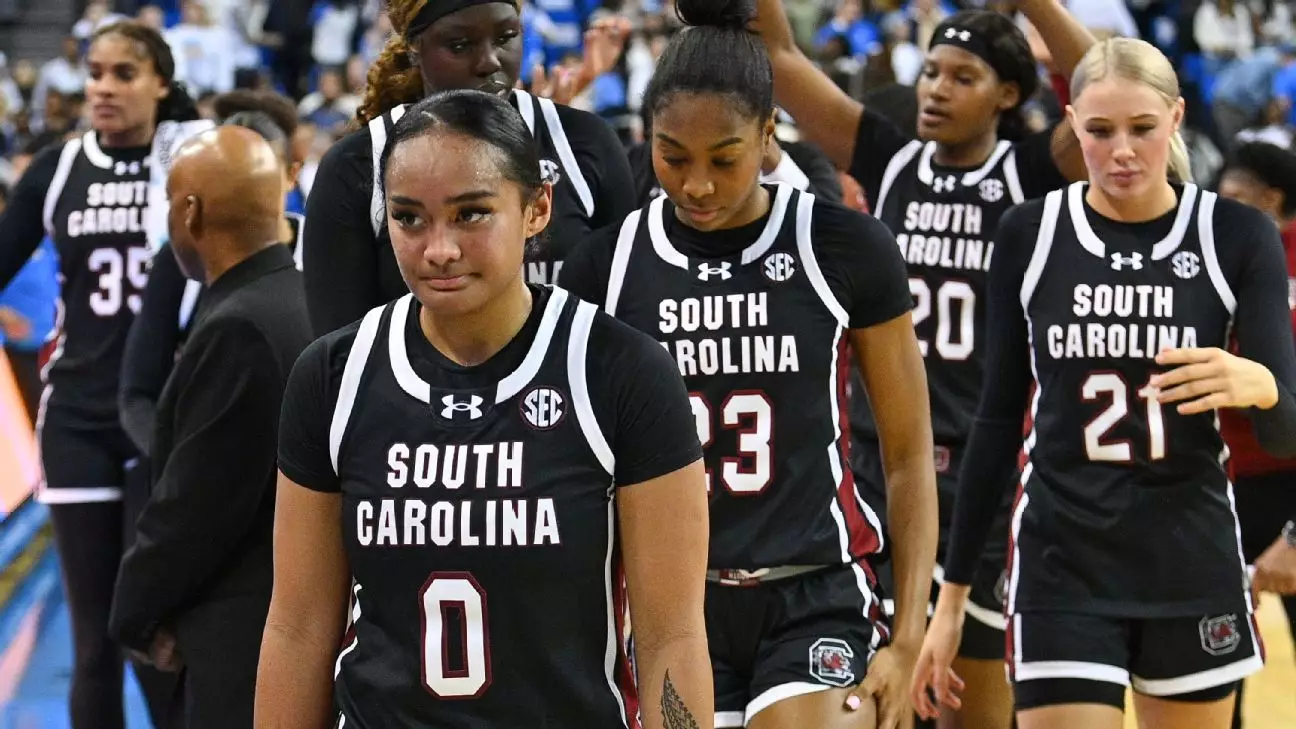When the South Carolina Gamecocks, reigning champions and a powerhouse in collegiate women’s basketball, faced off against the fifth-ranked UCLA Bruins, expectations were set high. South Carolina had dominated the court for an astonishing 43 consecutive games, a streak that epitomized their strength and strategy under the tutelage of head coach Dawn Staley. However, the game played at Pauley Pavilion on Sunday brought an unexpected twist, as UCLA delivered a commanding 77-62 defeat, marking a significant shift in the league’s hierarchy.
This loss was not only a harsh reality check for the Gamecocks but also a groundbreaking event for UCLA, as it was their first-ever victory against a team ranked No. 1 by the Associated Press, making history in their program. The Bruins demonstrated resilience and tactical prowess, challenging South Carolina at every turn. The seamless execution of their strategies underscored the potential they have this season.
The afternoon began somewhat evenly, with South Carolina struggling to find their rhythm. Despite their efforts, they found themselves on the defensive as UCLA escalated their game intensity. At one point, the Bruins built up a 23-point lead, asserting dominance with relentless defense that stifled South Carolina’s offense and held them to a mere 36.4% shooting performance from the field. Staley remarked on her team’s attempt to contain the standout Bruins center, Lauren Betts, but the overall execution from the Gamecocks fell short.
UCLA’s “relentless” defense became a critical cornerstone of their victory. Having previously been challenged by unranked teams without severe consequences, the Gamecocks faced a well-rounded coffering of UCLA players capable of flexing offensive muscles. Notably, Londynn Jones came off the bench to make an impact, sinking perfect three-point shots, while Te-Hina Paopao and Tessa Johnson contributed significantly to the scoring effort. Their collective efforts ensured that the Gamecocks’ defense had to stretch itself thin, leading to substantial offensive shortcomings for South Carolina.
As the halftime buzzer sounded with the Bruins leading by 21 points, it became clear that the Gamecocks were not merely facing a temporary setback but a potential crisis. Staley’s team managed only 22 points in the first half, a stark contrast to their typically explosive scoring capabilities. The 26.5% shooting clip at the break was alarming; this was unprecedented for a team that had been a lynchpin of consistent quality in women’s collegiate basketball over recent seasons.
Staley articulated the frustration felt by her team, recognizing both the challenge of adjusting to a period without a dominant big player and the need for recalibration. Her comments about transitioning away from players like 2024 WNBA lottery pick Kamilla Cardoso became a frank acknowledgment of the evolving challenges the Gamecocks were now facing. The focus must now shift toward rediscovering their identity as a team while overcoming heightened competition.
On the other side of the equation, UCLA demonstrated that they are not merely opportunistic but are a force to be reckoned with. The impressive output from their bench is indicative of their depth, with coach Cori Close emphasizing the selflessness and work ethic that fueled this triumphant game. The energy resonating throughout Pauley Pavilion, filled with enthusiasm and history, reminded everyone why UCLA remains a revered name in women’s basketball.
As they look ahead, Close’s vision appears clear and focused: this victory is merely the beginning of an ongoing journey. The players are not overly concerned with immediate rankings; they wish to delve deeper into the lessons learned from each match. With aspirations to make their mark in this season and potentially secure a berth in the NCAA Final Four, UCLA seems poised for greatness.
As South Carolina nurses the wounds of this defeat, a critical question arises: how will they adapt to the shifting landscape of competitive play? The continual evolution within NCAA women’s basketball means that teams must remain agile, responsive to not just player changes but also the strategic modifications made by loyal competitors. For the Gamecocks, ensuring their playing style aligns with current player capabilities will be paramount.
The historic loss against UCLA serves as a multifaceted lesson, illuminating vulnerabilities while shining a light on areas for growth both on and off the court. As the teams head into future match-ups, it will be exciting to see how they evolve, with UCLA reveling in newfound momentum and South Carolina striving to reclaim their formidable presence in women’s basketball. One thing is clear: the landscape of college women’s basketball just got considerably more intriguing.


Leave a Reply